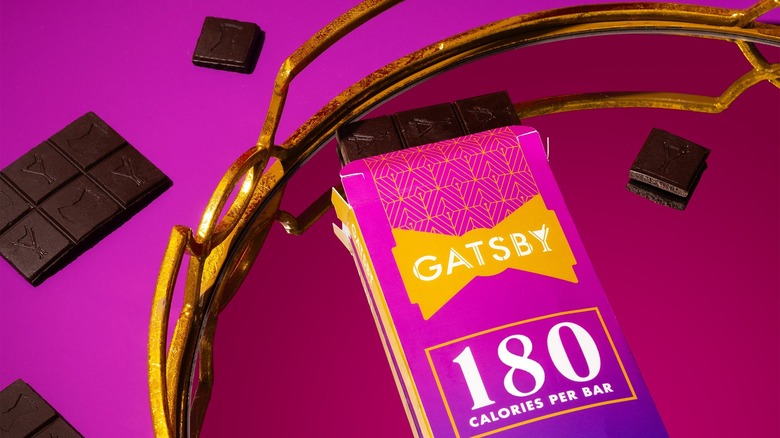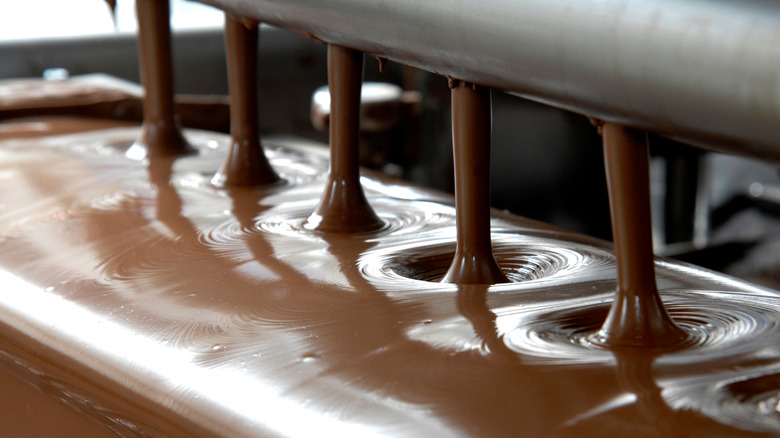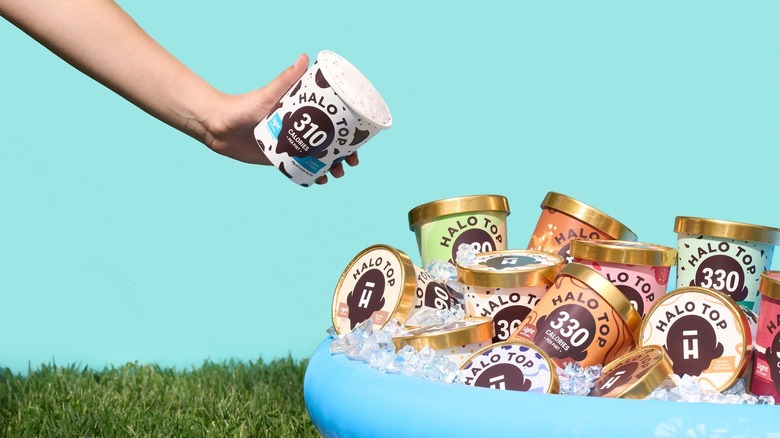What You Need To Know About Gatsby Chocolate From Shark Tank
Everybody loves chocolate and "Shark Tank" hopeful Gatsby Chocolate promises all the flavor of a chocolate bar with only half of the calories. Their chocolate bars boast 65 calories per gram compared to 145 calories per gram in a Lindt chocolate bar — that's even less than half of your favorite guilty pleasure. And it's all wrapped up in stylish Art Deco packaging inspired by the Roaring '20s.
The brand's chocolate products have already earned some fans prior to their TV debut. "Great flavor! Especially if you love dark chocolate. Didn't realize until later it was low cal!" one review exclaimed of the Almond Dark Chocolate Style Bar. As of publication, the bar has a 4.8 average rating on Walmart. However, not everyone loves the low-calorie treat. One critic called it "gritty and bitter," while another complained of "serious GI upset" after eating a bar.
According to founder and CEO Doug Bouton, the company's biggest demographic is "Power Women": Women in their mid-twenties to mid-thirties with a lot on their plate. But Gatsby Chocolate has rolled out a range of products to appeal to other target markets, too — including vegans and people who can't eat gluten. Intrigued? Here's everything you need to know about Gatsby Chocolate.
It's not technically chocolate
Gatsby Chocolate claims to produce a product with half the calories and a quarter of the sugar of a traditional chocolate bar. What's the catch? Put simply, Gatsby Chocolate isn't really chocolate. Not according to the Food and Drug Administration, anyway.
According to FDA regulations, a bar of milk chocolate must be made with chocolate liquor, a blend of cocoa solids and cocoa butter; it can also contain added milkfat and caloric sweeteners. Gatsby Chocolate products don't meet these requirements. Its bars simply contain cocoa powder (no cocoa solids or cocoa butter) and calorie-free allulose (a sweetener), while the fat content comes from esterified propoxylated glycerol (EPG), a plant-based fat alternative. That's why the company has to market its products as "chocolate-style bars."
These ingredients are also why the company's products are so low in calories. A gram of allulose contains just a tenth of the calories of a gram of sugar. Plus, a gram of EPG contains about a ninth of the calories of a gram of butter. "Chocolate has been made with cocoa butter for hundreds of years, and the industry really took it for granted. We wanted to look at that fresh and ask, could we not only cut the sugar but also cut the fat?" CEO Doug Bouton told The Local Moms Network.
The founder is part of the team who brought you Halo Top
This isn't the first time Gatsby Chocolate's CEO and founder, Doug Bouton, has launched a health food company. He was an early partner in Halo Top Creamery, the best-selling low-calorie ice cream brand. He helped take the company from a revenue of $12,000 a year to hundreds of millions per year before it was acquired by Wells Enterprises.
"After selling Halo Top in 2019, I – along with a bunch of other Halo Top team members – were trying to figure out what to do next," Bouton told The Local Moms Network. "We looked at different food categories and settled on chocolate because there were no other low-calorie chocolates; literally none." Its main competitor, Lily's, sells low-sugar, but not necessarily low-calorie, chocolate.
The parallels between Halo Top and Gatsby Chocolate are obvious: They're two brands that market low-calorie versions of high-calorie treats. But it remains to be seen whether Gatsby Chocolate will match Halo Top's multi-million-dollar profits.
What happened to Gatsby Chocolate on Shark Tank?
When it was time to face the sharks, Doug and Ryan Bouton — who are brothers, as well as business partners — gave a slick, professional presentation of the Gatsby brand. "We call it the Halo Top of chocolate," Ryan said."And sharks, we can actually say that because...I'm the co-founder of Halo Top," Doug finished. That sparked some oohs and ahs from the investors. But they stopped once the Boutons made their ask: $500,000 for a 5% stake in the company.
Then the questions started coming. How much free cash flow does the company have? None. How much money did it lose last year? $3.5 million. Why on earth does the logo have a cocktail glass in it? "I was thinking that this was somehow, like, liquor-flavored chocolate," entrepreneur Lori Greiner remarked.
Despite the nonexistent profits and confusing branding, multiple sharks wanted in. Ultimately, Greiner and Cuban teamed up to offer $250,000 in loans and $250,000 in investments for a 20% stake in the company — with a catch. Once Gatsby Chocolates hit $10 million in sales, their stake would jump to 30%, and once they hit $20 million, they'd again jump to a whopping 40%.
The brothers managed to negotiate the $20 million threshold to $50 million. Gatsby Chocolate walked away with a total of $500,000 in loans and investments. It remains to be seen whether that cash injection will help the company become one of the biggest Shark Tank food wins.



